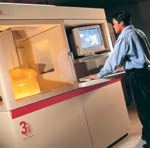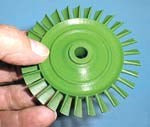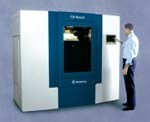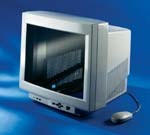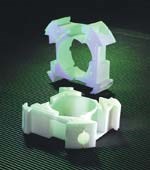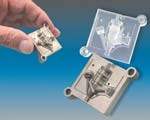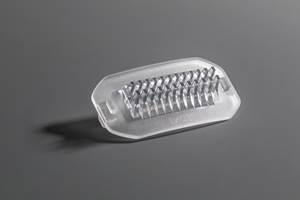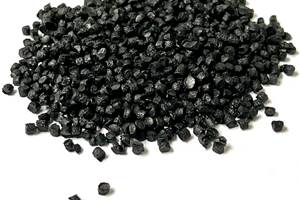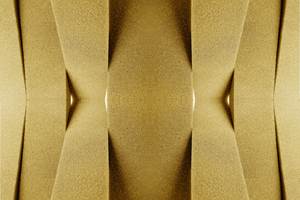Rapid Prototyping: Pretty Soon, You Won't Be Able To Get Along Without It
Bigger, faster, more accurate machines and more durable materials threaten to make "RP" indispensable for product and tool development. Molders also find RP models aid accurate price quoting. Next up: ‘rapid manufacturing' of production parts.
Since their first commercial launch in the late 1980s, rapid-prototyping (RP) technologies have aimed to speed up product development. RP systems can shave weeks or months off the development cycle by allowing design engineers to create a solid model directly from CAD data. They can thereby realize an immediate physical representation of designs and check form-and-fit issues. Besides being faster, RP systems can also model more complex geometries than can conventional methods such as CNC machining.
RP started out as a tool for large OEMs in aerospace, automotive, and consumer products. In the next few years, rapid prototyping may become standard procedure for plastics processors large and small. Making that possible are improvements in materials and throughput of RP equipment; the advent of smaller and more affordable systems; and wider recognition of how RP can be a powerful business tool for processors.
Growing awareness
According to RP guru and consultant Terry Wohlers, president of Wohlers Associates in Fort Collins, Colo. (www.WohlersAssociates.com), the number of RP installations worldwide is still fewer than 7000. He estimates that 85-90% of RP equipment is located at service bureaus and model shops. A worldwide directory of over 500 RP service bureaus appears on the web site of Castle Island Co., Arlington, Mass., an on-line RP information source (http://home.att.net/~castleisland). The proliferation of service bureaus makes it unnecessary for most molders to own their own RP equipment. Instead, they can send their designs over the Internet to a service bureau, which will "print" and ship a model within a day or two.
Accelerated Technologies Inc. (ATI) is one of the country's largest RP service bureaus. Marketing manager Todd Grimm predicts that more plastics processors will be using RP models to facilitate more accurate price quotes and delivery estimates. They might start by borrowing an RP model from the customer.
One custom injection molder that adopted RP for in-house use is Metro Plastics Technologies. According to president Lindsey Hahn, having a physical example of the part can help avoid a lot of errors in tool design that might occur if you have only a CAD model, and it can save time and money as well. "Toolmakers tend to quote a more attractive price when there is a physical model at hand, whereas with a CAD model, they tend to play it safe," Hahn explains. "Also, if your engineering staff has a physical model, they can work on the packaging, material handling, automation, and fixturing before or while tooling is being made."
Metro Plastics Technologies has provided its customers with stereolithography models as a value-added service for nearly 10 years. Expanding its capacity to four SLA machines in the last four years, Metro now also operates an RP service bureau for OEMs and other molders. "The interest from other injection molders has been keen," Hahn notes. Metro offers instant price quotes for SLA models on-line. Users simply provide part dimensions and volume.
The main RP technologies
Worldwide, there are about two dozen companies supplying RP equipment and materials, says Wohlers. Although the materials and processes differ, the approach of most RP systems is similar. It entails the electronic "slicing" of a 3D CAD file into a series of thin cross sections, translating the results into 2D position coordinates, and using these data to control placement of the "build" material. This process is repeated for each cross section and the object is built from the bottom up, one layer at a time.
Stereolithography (SLA) is the original and still most widely used RP system. RP pioneer 3D Systems sold 1600 SLA machines from 1988 through 1999, according to the Wohlers Report 2000, an RP industry report from Wohlers Associates. An SLA machine builds objects by directing uv light from a computer-controlled laser onto the surface of a vat of photosensitive liquid resin. When the light strikes the surface, the photopolymer solidifies. When one layer is completed, the part is lowered into the vat, a thin layer of new liquid spreads over the surface, and the process is repeated. Because each layer is as thin as 0.001in., objects can be made with very fine details. SLA machines cost $100,000 to $800,000.
Selective Laser Sintering (SLS), the second most popular RP technology, builds objects from a bed of fine powder that is sintered by a traveling laser beam. The powder is of plastic or plastic-coated metal or ceramic particles. DTM Corp. installed 318 of its Sinterstation machines by the end of 1999, according to Wohlers. Prices range from about $270,000 to $325,000.
Fused deposition modeling (FDM) is the next most well-known process. Stratasys Inc. had 1285 installations at the end of 1999, by Wohlers' count. The FDM machine is essentially a high-tech hot-glue gun mounted on an x-y plotter mechanism. It extrudes a thermoplastic material such as ABS. A filament of material is fed into an extrusion head and heated to a semi-liquid state. To form each layer of the model, the head extrudes a thin bead of plastic that solidifies as soon as it has been extruded. Prices range from $100,000 to around $300,000.
Newer entrants in the RP business are 3-D printers suited to making quick form-and-fit concept models. They use the ink-jet principle to deposit droplets of materials in successive layers. These systems are built to run in office environments and require minimal training. Their detail resolution and the properties of the materials used with these "printers" are much more limited than with other RP processes. However, these systems are as much as 10 times faster and about one-third as costly.
In 1995, the first of these systems on the market was the Actua modeler from 3D Systems, which now has a new and faster version, called ThermoJet. These are known as thermal ink-jet printers, which dispense droplets of molten thermoplastic.
Another system of this type was introduced in 1996 by Solidscape Inc. (formerly Sanders Prototype, Inc.). Its 3D modeler accounted for more than 519 units in use through 1999. Its dual deposition system places droplets of a proprietary thermoplastic build material and a soluble wax support. This technology is also licensed by a new company, Sanders Design International, which introduced a competing machine, the Rapid PatternMaker (RPM), in 1999. Both systems cost $75,000 to $80,000.
Another new thermal ink-jet printer was introduced in 1999 by Stratasys, and an Israeli machine is expected to enter the North American market next month.
A different sort of 3D printer is the Z 402 system from Z Corp., which debuted in 1997. (List price: $57,000.) Its print head deposits an aqueous binder on the build material, which is powdered corn starch or plaster. Wohlers says Z Corp. is one of the fastest-growing RP equipment suppliers. It placed over 161 units in the field through 1999.
Strengths & limitations
Stereolithography's strengths lie in part quality. The process produces a highly accurate model with excellent surface finish. According to Wohlers, these factors make SLA suitable for visual presentations and patterns for tooling. On the other hand, SLA involves high equipment, material, and maintenance costs, and requires significant training.
SLA has also been limited by its photopolymer materials, which suffered from brittleness and properties that can change with humidity and ambient temperature. However, newer SLA materials from Vantico (formerly Ciba Specialty Chemicals) and DSM Somos have evolved from acrylic-based to epoxy-based polymers. One of the newest of these is said to emulate PP.
An advantage of the SLS process is that it can make parts from thermoplastics—proprietary nylon materials, which can be glass-filled. Wohlers says SLS prototypes now approach the aesthetic quality of stereolithography. "SLS's limitations have been in producing models with super-crisp edges and a surface finish like stereolithography. However, the improvements over the last few years have been impressive," On the other hand, SLS has a significant learning curve, similar to SLA. And fine powder residues on parts require extra clean-up effort.
FDM's strength lies in its simplicity. It extrudes a filament of proprietary ABS material through a heated tip. "Users of FDM like the strength of the ABS plastic. Still, they gain material strength at the expense of a fine surface finish, compared with SLA models," says Wohlers. The durable ABS models made with FDM can be sanded, drilled, painted, and tested for fit and function. Also, the FDM machine is suitable for an office environment.
The major advantage of Z Corp.'s Z 402 modeler is its speed, which outperforms all other RP methods, according to Wohlers. It uses low-cost starch- or plaster-based materials and is relatively affordable. Its limitations are in model quality. But the last year has seen improvements in materials, software, and the mechanics of deposition that produce higher accuracy and crisper edges.
Drew Santin, president of Santin Engineering, a product-development and custom molding firm, says Z Corp.'s machine can make models in one-tenth the time of SLA—1-2 hr vs. 8-10 hr for SLA. "We use it for conceptual industrial design to get the ergonomic look of the part. In the engineering stage, we use SLA to make tooling patterns using DSM Somos Series 7000 and 8000 resins, which emulate polypropylene."
Functional models
The major limitation of RP systems has been weak, brittle materials that made it difficult to create models that can be tested for form, fit, and function. But recent developments have moved toward tougher, stronger plastics that can produce functional models. Such models can permit ergonomic testing of a hand tool or cell phone, or could permit evaluation of fluid flow with a new pump impeller design.
API, for example, uses both SLA and SLS machines to produce functional prototypes. Says Grimm, "Functional is a relative term. The truth is most of the RP systems do not make totally functional parts because they do not use the actual end-use materials." He notes that new stereolithography materials mimic key properties of PP and PE.
"These prototypes are more functional than before, although they do not hit every property of the production thermoplastic." On the other hand, he says DTM's new Duraform nylons for SLS are truly functional materials. "So we use them for a lot of housing models for power tools or other products that will be field tested. However, you are still testing a material that won't be the one used in production."
Says Hahn of Metro Plastics, "When SLA first came out, some thought it would be a panacea until they realized they couldn't fully test parts for function. Most have now gone back to using an SLA model to produce a second model—a urethane casting to which you can add color and texture. The urethane model is reasonably functional in simulating the molded part."
Hahn also notes that while materials for SLA have improved dramatically in properties, they tend to be less accurate than the original materials. "You can now cure materials at a faster rate, but it is more difficult to get an extremely accurate prototype."
Systems based on thermal ink-jet printing technologies, like those from Solidscape and Sanders Design International, are highly accurate but comparatively slow in producing master patterns, and thus have not caught on with service bureaus. This trade-off of speed for quality positions these processes for small, detailed items like jewelry and small turbine blades, according to Grimm, who considers their detail and precision superior to those of SLA. These ink-jet modelers can produce layers as thin as 0.0005 in. vs. 0.001 in. for SLA. Santin, whose firm uses a Solidscape unit, says that although the ink-jet thermoplastic materials are not very strong, they can produce extremely thin prototypes for delicate medical parts.
‘Rapid manufacturing'?
If RP today can produce functional models, why not actual production parts? In fact, some RP techniques have already been used to manufacture finished products. What might be termed "rapid manufacturing" is still in its infancy and will take several more years to develop, says consultant Terry Wohlers. "Initially, it will happen where the unit price of a part is high and the volume is low, and also where the part is small—about the size that would fit within a 6-in. cube."
An example occurred at Boeing's Rocketdyne Div. in Canoga Park, Calif. It makes the main rocket engines for the NASA Space Shuttle and International Space Station. Using only DTM's SLS, Rocketdyne has built hundreds of production parts of glass-filled nylon or metal powder. The plastic parts are relatively small, fitting within a 5-in. cube. According to Charles Conner, DTM marketing manager, Rocketdyne's use of SLS for production manufacturing reduced the overall cost of each component by $30 to $300.
"If you can use RP for extreme environments like space, than there is a lot of opportunity for other industries, such as automotive," observes Wohlers. "At first, such activity will be limited to high-end personalized vehicles where volumes are lower," he speculates. In the medical area, he adds, rapid manufacturing will continue to make inroads in applications such as custom implants. Small customized parts for helicopter interiors such as structural parts for seats, cabinetry, or nameplates are other potential applications, Wohlers believes.
Says Drew Santin of Santin Engineering, "With today's faster more agile RP machines, the lines are starting to blur, and we look to see if we can make a production part with these machines. We already have customers for whom we have made, say, 10 production parts per year with an SLA machine. You could not make 10 parts economically with injection molding." The SLA production parts Santin has built are primarily electronic bobbins for solenoids—thin-wall parts that are tough to injection mold. Physical strength is not required of the SLA material, since the assembled components are encapsulated with another resin, Santin notes.
For low-volume manufacturing, both API and Metro Plastics Technologies have used SLA models to produce silicone rubber molds for casting urethane parts. These parts have been for niche applications like medical devices and racecar computer batteries.
The latest developments
A flurry of RP advances within just the last two years has produced new machines, software, and materials.
In stereolithography, 3-D Systems launched its largest SLA machine in 1999. The SLA 7000 has a maximum build area of 20 x 20 x 23.62 in. It boasts speed and surface-finish improvements, owing to enhancements such as a new dual-spot laser, low-vibration optical system, and simpler construction. It builds parts about four times faster than its forerunner, the SLA 5000. The 7000 can build layers as thin as 0.001 in., half the minimum of the SLA 5000.
3-D also introduced two epoxy-based photopolymers, the first in a new generation of materials with expanded capabilities. Produced exclusively for 3-D by Vantico, the new Cibatool grades are said to exhibit mechanical properties similar to those of thermoplastics such as PP, PE, and PS. Resulting parts are said to have sufficient durability and flexibility to withstand the rigors of functional testing involving snap fits or other means of assembly. New Cibatool SL 7540 is designed for the SLA 7000, 5000, and 3500 systems, while SL 5240 is for the SLA 250 system.
Last year, DSM Somos introduced its Somos 9100 series epoxy photopolymers for SLA. They mimic polypropylene's tensile strength and elongation, and are said to be durable enough to be used as models for making RTV silicone molds. Parts made with these resins can even substitute for injection molded parts in some production applications, DSM says. Somos 9100 is for SLA machines with Argon-ion lasers, while 9120 is designed for machines that use a solid-state laser.
DSM Somos also introduced an improved method for adding colors to finished SLA parts. Previous aqueous dyes do not work uniformly on all SLA resins and sometimes deform the part through prolonged soaking in the hot dye solution. The new method uses aniline-based dyes (also called leather dyes) in an alcohol solvent, which work at room temperature. They penetrate the surface of SLA prototypes made of Somos 7100, 8100, and 9100 series resins, making the color more permanent.
For SLS, DTM Corp. introduced its third-generation Sinterstation 2500plus machine in late 1998. It sells for $300,000, 25% lower than its predecessor, the SLS 2500, and builds parts about twice as fast. Enhanced thermal control of the build area, increased laser scan speed, and faster powder delivery account for the shorter build time. A benchmark test build of 11 parts of varying size, shape, and thickness took about 26 hr on the SLS 2000, 21 hr on the SLS 2500, and 15 hr on the SLS 2500plus.
In addition to its Duraform PA and Duraform GF nylon compounds, DTM also now offers Somos 201. Introduced by DSM Somos in 1999, this is a thermoplastic elastomer that allows SLS to now make flexible, rubber-like parts.
Last fall, Stratasys unveiled the new FDM Maxum machine, which operates 50% faster than previous FDM systems. It also offers one of the largest build envelopes in the RP industry. At 23.6 x 19.5 x 23.6 in., it accommodates either very large parts or numerous smaller parts. It uses two extrusion heads, one for building the model and the second for depositing the support material. The patented MagnaDrive control system moves both FDM heads using magnetics and a thin cushion of air. Its precision is said to result in models that are uniformly smooth with sharp details and tight tolerances.
Maxum features Stratasys' new WaterWorks aqueous support-removal method. Launched in 1999, it deposits a water-soluble support material that can be washed away in an ultrasonic cleaning tank, resulting in a clean ABS model with smooth surfaces.
Maxum also comes with new Insight preprocessing software that allows users to drag and drop CAD files to start the modeling process. Insight runs in Windows NT and has a new remote-notification feature that alerts users via e-mail or pager when a build job is done or interrupted. It also features a buildlog that tracks jobs by name, material usage, build times, and final result (aborted or completed).
Stratasys is developing materials with even higher HDT, toughness, and chemical resistance than its current ABS products. Product manager Ward Jensen says new grades will also offer flame resistance. A new machine to accommodate new materials is also in the offing.
The last two years have been particularly active in 3D-printer or concept-modeler developments. In mid-1999, 3-D Systems introduced its latest concept modeler, the ThermoJet, which boasts a three-fold increase in build speed over the company's earlier Actua machine. Higher speed results from use of 360 deposition jets on the new machine vs. 96 on the Actua. ThermoJet lists at $49,000.
Also in 1999, Stratasys introduced the Prodigy 3D printer, which allows designers to test form, fit, and function with durable ABS parts produced within an office environment. It's priced at around $65,000.
The Israeli firm Objet Geometries Ltd. is expected to enter the North American market next month with its new Quadra RP machine. It is based on new ink-jet technology that reportedly offers very high resolution (over 600 dpi) and is very fast. It uses a proprietary photopolymer said to offer properties unavailable with other ink-jet systems, along with aesthetics comparable to stereolithography. Machine price is about $39,000.
With last year's introduction of the Z402C 3D Color Printer, Z Corp. became the first RP equipment supplier to offer a device that makes parts in multiple colors without secondary operations. Color is applied to the surface of the parts to a uniform depth of about 0.08 in. A typical small part can be printed in 1-2 hr in monochrome or 3-6 hr in full color.
User-selectable layer thickness ranges from 0.003 to 0.010 in. CEO Marina Hatsopoulos says the new system is useful for complex designs and assemblies. That capability is enhanced by the new ZP100 plaster build material, which is said to allow production of thin-wall parts with more complex geometry than is possible with the company's starch-based materials.
Last April, Solidscape introduced PatternMaster, a new pattern-making system geared to industrial applications, whereas the earlier ModelMaker systems were geared more to the jewelry market. PatternMaster is said to provide faster builds plus improved accuracy and surface finish with no secondary finishing. It's capable of layer thickness as fine as 0.0005 in. and surface-finish resolution of 32-63 micro-inches (RMS). It makes master patterns as large as 12 x 6 x 8.5 in.
Also last April, Sanders Design International introduced the new Rapid ToolMaker (RTM) system for making prototype high-precision tooling patterns. It has a build volume of 18 x 12 x 12 in. and provides surface finish to one-half micron (RMS). It has a milling head that planes each layer to thicknesses from 0.0005 in. to 0.005 in. Its build-table elevator is digitally controlled to 0.000125 in. SDI president Al Hastbacka says these two features allow models to be built with variable slice thicknesses, which results in ultra-smooth surfaces, such as rounded contours without "stair-stepping."
Although the company licenses Solidscape's equipment and material technology, SDI has developed its own new material formulations. One is a water-dispersible version of its wax support material. It also modified its proprietary thermoplastic ink to ensure flatness of larger parts made possible by the increased build envelope.
Related Content
Ether-Based TPUs for Broad Range of Industry Applications
BASF’s Elastollan 1400 TPU series can be used for applications ranging from railway pads, hoses and profiles to show soles.
Read MoreTracing the History of Polymeric Materials, Part 25: Silicones
The long road to the development of silicone resulted in a chemistry that is remarkably versatile.
Read MoreTPE Made with 50% PCR Derived from End-of-Life Tires
Prism Worldwide has commercialized its first TPE with this type of recycled content based on its patented technology.
Read MoreTracing the History of Polymeric Materials -- Part 30: Polyurethane
In the world of polymers, polyurethane chemistry is probably the most versatile. This a resulted in a wide range of products made from these materials and given the industry the flexibility to respond to the progressive march of regulatory concerns.
Read MoreRead Next
Lead the Conversation, Change the Conversation
Coverage of single-use plastics can be both misleading and demoralizing. Here are 10 tips for changing the perception of the plastics industry at your company and in your community.
Read MoreBeyond Prototypes: 8 Ways the Plastics Industry Is Using 3D Printing
Plastics processors are finding applications for 3D printing around the plant and across the supply chain. Here are 8 examples to look for at NPE2024.
Read More



